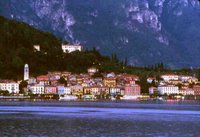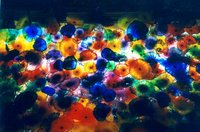

Don’t overlook small museums.
They often have great stuff that you can enjoy without the hassle, crowds or ticket prices of their stuffy, celebrated sisters. Four miles from my house, in Brockton, Massachusetts – birthplace of fighter Rocky Marciano and a shoemaking mecca in its heyday – sits the Fuller Craft Museum, a rare Brockton cultural gem. (The city is trying mightily to revitalize itself, and a few seasons ago it scored a home run by enticing actor Bill Murray and a group of investors to fund the Brockton Rox, a pro baseball team whose home field is a beautiful new stadium next to Brockton High School. Working as a Rox usher has become the cool summer job for area teens. Bill Murray Bobble Head Night is in the lineup for July.)
Brockton is the last place I would have expected to encounter great art. But it’s at the Fuller that I discovered the masterful work of glass artist Dale Chihuly. Chihuly’s ethereal glass creations have graced some of the world’s most renowned museums, but the tiny Fuller managed a few years back to get hold of roomsful and mounted a special exhibition.
As the kids and I wandered the galleries blooming with back-lit, blown-glass Technicolor flowers and other crystal creations, I understood why Dale Chihuly was honored, in 1992, as the first National Living Treasure by the Institute for Human Potential at the University of North Carolina at Wilmington.
Just as places are designated as treasures because of their cultural or historic importance, so are people in the arts. In 1950, the government of Japan was first to begin selecting accomplished artists as Living National Treasures. Japan's model of honoring valuable cultural contributors, and subsequent selection guidelines espoused by UNESCO, have since taken root in countries, institutions, states like Hawaii, and tribes like the Cherokee that wish to recognize their human, "intangible treasures."
Having been turned on in Brockton to the work of a National Living Treasure, naturally the first thing I wanted to do when I got to Las Vegas was see Dale Chihuly’s Fiori di Como, Flowers of Como, the 40,000-pound blown-glass explosion that hangs on a 10,000-pound steel armature and covers the ceiling of the Bellagio Hotel’s lobby.
Before I could view the glass masterpiece, I had to get the kids past Bill, the Bellagio security guard, who, thankfully, was having a mellow day and providing only spotty enforcement of the hotel’s "Under 18 Policy." Families be warned: the Bellagio does not want you.
Bill was stationed next to the "Must be 18 or registered guest to enter the hotel" sign. I chatted him up and found he was from Watertown, New York, a place I pretended to know something about: "Watertown... nice quiet place..." Bill, either gullible or homesick, lit up, pointed to the sign and said, "They enforce it more on the weekdays, less on the weekends, so go ahead."
Dana and Adam were the only kids in the entire place (save for two tow-heads, coutured by Gap and pulling cutesy backpacks on wheels, who were checking into a suite with their flashy parents), and it was weird. I couldn’t wait to see the Chihuly ceiling and hightail it out of the Bellagio.
If you’re in Vegas, see the Chihuly ceiling, even if you have to leave the kids at the door while you dash in. (Bill’s probably retired, and the Bellagio now makes a point of posting its exclusionary policy on its Web site, so the odds of sneakin' the young ‘uns in are slim.)
Probably easier to fly to Italy to see the real Bellagio, a dreamy town on Lake Como, home to George Clooney, and just an hour’s drive north of Milan.
When I dug out a photo of Bellagio, taken from the lakefront balcony of our lovely, high-ceilinged connecting rooms at the Hotel Britannia Excelsior in Cadennabia (to get special treatment at the best price, deal directly with the owners by e-mail or fax when booking a non-chain hotel), I could see how Bellagio’s color and magic inspired Chihuly’s Vegas masterpiece.
www.LoriHein.com
